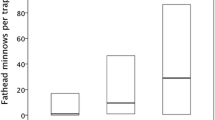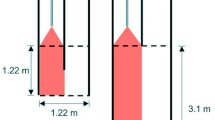Abstract
In laboratory and field-trapping studies, we exposed fathead minnows (Pimephales promelas) and finescale dace (Chrosomus neogaeus) to hypoxanthine-3-N-oxide and a suite of structurally and functionally similar compounds in order to determine if: (1) hypoxanthine-3-N-oxide functions as a chemical alarm signal in ostariophysan fishes and (2) the purine skeleton, a structural component, or the nitrogen oxide, a functional component, or both act as the molecular trigger in this chemical alarm signaling system. Minnows and dace exhibited significant antipredator responses when exposed to conspecific skin extract or hypoxanthine-3-N-oxide (increased shoaling and decreased area use) and the functionally similar pyridine-N-oxide (increased shoaling) but not to structurally similar molecules lacking a nitrogen oxide functional group or to a swordtail skin extract control. Field-trapping studies revealed similar results. Traps labeled with fathead minnows skin extract, hypoxanthine-3-N-oxide, or pyridine-N-oxide caught significantly fewer fish than did those labeled with distilled water. These data strongly suggest that the nitrogen oxide functional group acts as the chief molecular trigger in the Ostariophysan alarm pheromone system and that, contrary to previous research, hypoxanthine-3-N-oxide may be one of several possible molecules that function as a chemical alarm signal. Here we report the first example of a single functional group capable of eliciting a suite of behavioral responses.
Similar content being viewed by others
REFERENCES
Brown,Ñ G.ÑE.,ÑandÑ Godin,Ñ J.-G.ÑJ.Ñ1997.ÑAnti-predatorÑresponseÑtoÑconspecificÑandÑheterospecificÑskinÑextractÑbyÑthreespineÑsticklebacks:ÑAlarmÑpheromoneÑrevisited.ÑBehaviourÑ134:1123–1134.
Brown,Ñ G.ÑE.,ÑandÑ Godin,Ñ J.-G.ÑJ.Ñ1999a.ÑWhoÑdares,Ñlearns:ÑChemicalÑinspectionÑbehaviourÑandÑacquiredÑpredatorÑrecognitionÑinÑaÑcharacinÑfish.ÑAnim.ÑBehav.Ñ57:475–481.
Brown,Ñ G.ÑE.,ÑandÑ Godin,Ñ J.-G.ÑJ.Ñ1999b.ÑChemicalÑalarmÑsignalsÑinÑwildÑTrinidadianÑguppiesÑ(PoeciliaÑreticulata).ÑCan.ÑJ.ÑZool.Ñ77:562–570.
Brown,Ñ G.ÑE.,ÑandÑ Smith,Ñ R.ÑJ.ÑF.Ñ1997.ÑConspecificÑskinÑextractÑelicitsÑantipredatorÑbehaviourÑinÑjuvenileÑrainbowÑtroutÑ(OncorhynchusÑmykiss).ÑCan.ÑJ.ÑZool.Ñ75:1916–1922.
Brown,Ñ G.ÑE.,Ñ Chivers,Ñ D.ÑP.,ÑandÑ Smith,Ñ R.ÑJ.ÑF.Ñ1995a.ÑLocalizedÑdefecationÑbyÑpike:ÑAÑresponseÑtoÑlabellingÑbyÑcyprinidÑalarmÑpheromone?ÑBehav.ÑEcol.Ñ36:105–110.
Brown,Ñ G.ÑE.,Ñ Chivers,Ñ D.ÑP.,ÑandÑ Smith,Ñ R.ÑJ.ÑF.Ñ1995b.ÑFatheadÑminnowsÑavoidÑconspecificÑandÑheterospecificÑalarmÑpheromoneÑinÑtheÑfaecesÑofÑnorthernÑpike.ÑJ.ÑFishÑBiol.Ñ47:387–393.
Chivers,Ñ D.ÑP.,ÑandÑ Smith,Ñ R.ÑJ.ÑF.Ñ1998.ÑChemicalÑalarmÑsignallingÑinÑaquaticÑpredator-preyÑsystems:ÑAÑreviewÑandÑprospectus.ÑEcoscienceÑ5:338–352.
Chivers,Ñ D.ÑP.,Ñ Brown,Ñ G.ÑE.,ÑandÑ Smith,Ñ R.ÑJ.ÑF.Ñ1996.ÑTheÑevolutionÑofÑchemicalÑalarmÑsignals:ÑAttractingÑpredatorsÑbenefitsÑalarmÑsignalÑsenders.ÑAm.ÑNat.Ñ148:649–659.
Hazlett,Ñ B.ÑA.Ñ1997.ÑTheÑorganisationÑofÑbehaviourÑinÑhermitÑcrabs:ÑResponseÑtoÑvariationÑinÑstimulusÑstrength.ÑBehaviourÑ134:59–70.
Kawashima,Ñ H.,ÑandÑ Kumashiro,Ñ I.Ñ1969.ÑStudiesÑofÑpurineÑN-oxides.ÑIII.ÑTheÑsynthesisÑofÑpurineÑN-oxides.ÑBull.ÑChem.ÑSoc.ÑJpn.Ñ42:750–755.
Lawrence,Ñ B.,ÑandÑ Smith,Ñ R.ÑJ.ÑF.Ñ1989.ÑTheÑbehavioralÑresponseÑofÑsolitaryÑfatheadÑminnows,ÑPimpephalesÑpromelas,ÑtoÑalarmÑsubstance.ÑJ.ÑChem.ÑEcol.Ñ15:209–219.
Lemly,Ñ A.ÑD.,ÑandÑ Smith,Ñ R.ÑJ.ÑF.Ñ1985.ÑEffectsÑofÑacuteÑexposureÑtoÑacidifiedÑwaterÑonÑtheÑbehavioralÑresponseÑofÑfatheadÑminnows,ÑPimephalesÑpromelas,ÑtoÑchemicalÑfeedingÑstimuli.ÑAquat.ÑToxicol.Ñ6:25–36.
Lemly,Ñ A.ÑD.,ÑandÑ Smith,Ñ R.ÑJ.ÑF.Ñ1987.ÑEffectsÑofÑchronicÑexposureÑtoÑacidifiedÑwaterÑonÑchemoreceptionÑofÑfeedingÑstimuliÑbyÑfatheadÑminnowsÑ(PimephalesÑpromelas):ÑMechanismsÑandÑecologicalÑimplications.ÑEnviron.ÑToxicol.ÑChem.Ñ6:225–238.
Magurran,Ñ A.ÑE.,Ñ Irving,Ñ P.ÑW.,ÑandÑ Henderson,Ñ P.ÑA.Ñ1996.ÑIsÑthereÑaÑfishÑalarmÑpheromone?ÑAÑwildÑstudyÑandÑcritique.ÑProc.ÑR.ÑSoc.ÑLondonÑSer.,ÑB.Ñ263:1551–1556.
Mathis,Ñ A.,ÑandÑ Smith,Ñ R.ÑJ.ÑF.Ñ1993a.ÑIntraspecificÑandÑcross-superorderÑresponsesÑtoÑchemicalÑalarmÑsignalsÑbyÑbrookÑsticklebacksÑ(CulaeaÑinconstans).ÑEcologyÑ74:2395–2404.
Mathis,Ñ A.,ÑandÑ Smith,Ñ R.ÑJ.ÑF.Ñ1993b.ÑChemicalÑalarmÑsignalsÑincreaseÑtheÑsurvivalÑtimeÑofÑfatheadÑminnowsÑ(PimephalesÑpromelas)ÑduringÑencountersÑwithÑnorthernÑpikeÑ(EsoxÑlucius).ÑBehav.ÑEcol.Ñ4:260–265.
Mathis,Ñ A.,Ñ Chivers,Ñ D.ÑP.,ÑandÑ Smith,Ñ R.ÑJ.ÑF.Ñ1995.ÑChemicalÑalarmÑsignals:ÑPredatorÑdeterrentsÑorÑpredatorÑattractants?ÑAm.ÑNat.Ñ146:994–1005.
Mathis,Ñ A.,Ñ Chivers,Ñ D.ÑP.,ÑandÑ Smith,Ñ R.ÑJ.ÑF.Ñ1996.ÑCulturalÑtransmissionÑofÑpredatorÑrecognitionÑinÑfishes:ÑIntraspecificÑandÑinterspecificÑlearning.ÑAnim.ÑBehav.Ñ51:185–201.
Moyle,Ñ P.ÑB.,ÑandÑ Cech,Ñ J.ÑJ.Ñ1988.ÑFishes:ÑAnÑIntroductionÑtoÑIchthyology,Ñ2ndÑed.ÑPrenticeÑHall,Ñ EnglewoodÑCliff,ÑNewÑJersey.
Nelson,Ñ J.ÑS.Ñ1984.ÑFishesÑofÑtheÑWorld,Ñ2ndÑed.ÑWiley-Interscience:Ñ NewÑYork.
Parham,Ñ J.ÑC.,Ñ Fissekis,Ñ J.,ÑandÑ Brown,Ñ G.ÑB.Ñ1966.ÑPurineÑN-oxides.ÑXVIII.ÑDeaminationÑofÑadenineÑN-oxideÑderivatives.ÑJ.ÑOrg.ÑChem.Ñ31:966–968.
Pfeiffer,Ñ W.Ñ1977.ÑTheÑdistributionÑofÑfrightÑreactionÑandÑalarmÑsubstanceÑcellsÑinÑfishes.ÑCopeiaÑ1977:653–665.
Pfeiffer,Ñ W.,Ñ Riegelbauer,Ñ G.,Ñ Meier,Ñ G.,ÑandÑ Scheibler,Ñ B.Ñ1985.ÑEffectÑofÑhypoxanthine-3-NoxideÑandÑhypoxanthine-1-N-oxideÑonÑcentralÑnervousÑexcitationÑofÑtheÑblackÑtetra,ÑGymnocorymbusÑternetziÑ(Characidae,ÑOstariophysi,ÑPisces)ÑindicatedÑbyÑdorsalÑlightÑresponse.ÑJ.ÑChem.ÑEcol.Ñ11:507–523.
Scheinfeld,Ñ I.,Ñ Parham,Ñ J.ÑC.,Ñ Murphy,Ñ S.,ÑandÑ Brown,ÑG.ÑB.Ñ1969.ÑPurineÑN-oxides.ÑXV.Ñ3-N-OxidesÑofÑadenineÑandÑhypoxanthine.ÑJ.ÑOrg.ÑChem.Ñ34:2153–2156.
Smith,Ñ R.ÑJ.ÑF.Ñ1986.ÑEvolutionÑofÑalarmÑsignals:ÑroleÑofÑbenefitsÑderivedÑfromÑretainingÑgroupÑmembersÑorÑterritorialÑneighbours.ÑAm.ÑNat.Ñ128:604–610.
Smith,Ñ R.ÑJ.ÑF.Ñ1992.ÑAlarmÑsignalsÑinÑfishes.ÑRev.ÑFishÑBiol.ÑFish.Ñ2:33–63.
Smith,Ñ R.ÑJ.ÑF.Ñ1997a.ÑDoesÑoneÑresultÑtrumpÑallÑothers?ÑAÑresponseÑtoÑMagurran,ÑIrvingÑandÑHenderson.ÑProc.ÑR.ÑSoc.ÑLondon,ÑSer.ÑB.Ñ264:445–450.
Smith,Ñ R.ÑJ.ÑF.Ñ1997b.ÑAvoidingÑandÑdeterringÑpredators,Ñpp.Ñ163–190,ÑinÑJ.-G.ÑJ.Ñ GodinÑ(ed.).ÑBehaviouralÑEcologyÑofÑTeleostÑFishes.ÑOxfordÑUniversityÑPress,Ñ Oxford.
Smith,Ñ R.ÑJ.ÑF.,ÑandÑ Lawrence,Ñ B.Ñ1989.ÑEffectsÑofÑacuteÑexposureÑtoÑacidifiedÑwaterÑonÑtheÑbehavioralÑresponseÑofÑfatheadÑminnows,ÑPimephalesÑpromelas,ÑtoÑalarmÑsubstanceÑ(SchreckstoffÑ).ÑEnviron.ÑToxicol.ÑChem.Ñ7:329–335.
Wisenden,Ñ B.ÑD.,Ñ Chivers,Ñ D.ÑP.,Ñ Brown,Ñ G.ÑE.,ÑandÑ Smith,Ñ R.ÑJ.ÑF.Ñ1995.ÑTheÑroleÑofÑexperienceÑinÑriskÑassessment:ÑAvoidanceÑofÑareasÑchemicallyÑlabelledÑwithÑfatheadÑminnowÑalarmÑpheromoneÑbyÑconspecificsÑandÑheterospecifics.ÑEcoscienceÑ2:116–122.
Author information
Authors and Affiliations
Rights and permissions
About this article
Cite this article
Brown, G.E., Adrian, J.C., Smyth, E. et al. Ostariophysan Alarm Pheromones: Laboratory and Field Tests of the Functional Significance of Nitrogen Oxides. J Chem Ecol 26, 139–154 (2000). https://doi.org/10.1023/A:1005445629144
Issue Date:
DOI: https://doi.org/10.1023/A:1005445629144




